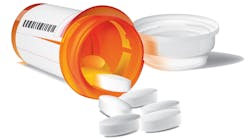Over-the-counter birth control: What dental professionals need to understand
Patient medication lists should be updated on every visit.1 Some medications are more common than others on patients’ health history paperwork, and women may be on some form of contraceptive medication.
In 2018, the Centers for Disease Control and Prevention estimated that 64.9% of women used some form of contraception.2 Contraceptive medications include oral pills, patches, gels, injections, implants, and intrauterine devices. Despite the different modalities, all were dispensed through a medical provider.3 Times are changing, and oral contraceptives will be available over the counter (OTC).
What to know about OTC Opill
In just a few weeks, Opill will be available at drug stores and other places where OTC medications and family planning items are sold. Opill, formally known as norgestrel, is making history because it’s the first oral contraceptive medication the FDA approved to be sold OTC.4
Opill is a progestin-only contraceptive, so it does not contain any estrogen, making it about 91% effective. Opill should be taken daily, and like all forms of contraceptives, may cause some side effects and have drug interactions. Research shows that these are fairly standard with all other types of contraceptive medications as well. It’s not known how much consumers will have to pay for Opill, but the goal is to make it affordable so it’s accessible.4
Opill is not the first progestin-only contraceptive medication; it’s similar to the mini pill, which is by prescription. The mini pill’s long-term benefits have shown that women who take it may have a lowered risk of endometrial cancer.5
Opill is not the first drug to go from prescription-based to OTC, but it’s the first contraceptive medication to do so.4,6 The FDA typically allows medications to switch after they’ve been tested for safety by reviewing their clinical trials and manufacturing process.6 One of the reasons Opill can be sold OTC is because it has only progestin in it.4,6
Research shows that all forms of OTC medication are less potent; thus, the dose is not individually specified as it would be for a prescription. Also, OTC meds are available to most people, so better access should come about because it’s safe for most people.6
What dental professionals must remember
It’s important for dental pros to understanding that women will have better access to another form of contraception. Dental professionals should also remember the relationship between contraceptive medication and oral health. Research shows that oral tissues are most often affected when a patient is taking some form of contraceptive medication due to the hormones in it. Gingival tissues may present as more inflamed or have increased bleeding. Other studies show that increased dental plaque and TMJ are additional symptoms that can more commonly occur in patients who take contraceptives.7
Dental professionals should document the names of any medications patients say they’re taking, whether prescribed or OTC. The pharmacological action of medication, its adverse effects on the oral cavity, and oral health education should be discussed with patients and noted in their medical record.8
Dental professionals should take the time to record any changes in a patient’s medical record, including medication or dosage,8 and should encourage patients to bring a list of medications with them to all appointments. Finally, they should discuss any potential oral cavity adverse effects or drug interactions when reviewing a patient’s medical chart.
References
1. Carr MP, Kearney R. Frequency of medical history updates. Dimensions of Dental Hygiene. March 16, 2017. https://dimensionsofdentalhygiene.com/article/frequency-medical-history-updates/
2. Rovenstein R. 2024 Birth control statistics. Health Education. January 24, 2024. https://www.singlecare.com/blog/birth-control-statistics/
3. Birth control options: things to consider. Mayo Clinic. February 16, 2022. https://www.mayoclinic.org/healthy-lifestyle/birth-control/in-depth/birth-control-options/art-20045571
4. Aungst C, Woodcock S. 7 things to know about Opill, the first FDA approved OTC birth control. GoodRx Health. May 14, 2024. https://www.goodrx.com/conditions/birth-control/fda-approves-opill-otc
5. Choosing a birth control pill. Mayo Clinic. December 3, 2022. https://www.mayoclinic.org/healthy-lifestyle/birth-control/in-depth/best-birth-control-pill/art-20044807
6. Lusk V, Woodcock S. 8 differences between OTC and prescription medications everyone should know. GoodRx Health. February 22, 2023. https://www.goodrx.com/drugs/otc/vs-prescription
7. Birth control side effects and oral health. Colgate. January 9, 2023. https://www.colgate.com/en-us/oral-health/adult-oral-care/birth-control-side-effects-oral-health#
8. Pieren JA, Gadbury-Amyot C. Darby and Walsh Dental Hygiene Theory and Practice. 2024. Elsevier.
About the Author

Tracee S. Dahm, MS, RDH
Tracee S. Dahm, MS, BSDH, is an adjunct clinical instructor for the North Idaho College School of Dental Hygiene. She also works in private practice. Dahm has been published in dental journals, magazines, webinars, and textbooks, and featured on dental podcasts. She is a key opinion leader on cutting-edge innovations in the hygiene field. Her research interests include trends in dental hygiene, improving access to dental care for the underserved, and mental health. She can be reached at [email protected].


